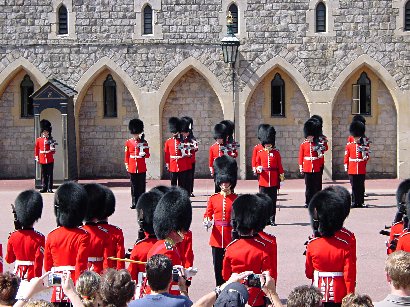Windsor Castle
Part of ring around London to both protect and control the city,
Windsor Castle sets on a hill 100 feet
above Thames, the only easily defensible area on the upper portion of the river.
Originally an earth and wood
castle built starting in 1080, stone began replacing wood in the 1170s.
The castle became a popular
royal residence because of a nearby hunting park, and it is now the Queen's favorite palace,
of which she opens up much of to the
public. The Round Tower roughly divides the Lower and Upper Wards, and we will follow a
fairly typical
tourist route from the train station in the town of Windsor that sprung up to serve
the castle.
|
 |

Lower Ward Walls
This is the view from the Pizza Express, an upscale
establishment which is nevertheless not as good as, and not as good
of a value as, Pizza Hut. Still, the view from the second floor is good,
isn't it? The Thames is off picture to left, and you can see that the
walls ascend a hill toward the right. The Curfew Tower appropriately
enough has a clock, and the windows were added after the walls were made
obsolete by gunpowder artillery.

Lower Ward Walls
Continuing to the tourist entrance, you can
see the Salisbury Tower on the left end of the photo, which can also be seen in
the previous photo. So you can see that this stretch of walls also
climbs uphill to the center of the castle, marked by the Round Tower on the far
right. The prominent exit on the left is the King Henry VIII Gate.

Continuing further toward the entrance, you can see the Mary
Tudor, Henry III, and Saxon Towers followed by a relatively short wall around
the Round Tower, which links up the Lower and Upper Ward walls. We'll next
go through a gate followed by the St. George's Gate.

This is the view looking from inside the low outer wall toward
the St. George's Gate. After a short exhibit on the castle, you can enter
the Lower Ward.

Lower Ward Looking Downhill
Approaching the castle from the train
station, we walked along the outside of the the walls on the left of the
picture. The Albert Memorial Chapel on the right dates to 1240s and was built by Henry
III. Beyond it is St. George's Chapel built starting in 1475s by Edward IV and
finished by Henry VIII. Ten kings and queens are buried in the chapel, and
it is the "spiritual home" of the Order of the Garter, founded by
Edward III in the 1300s.
The area of the distant wall is scene to the changing of
the guard when the queen is in residence. When I visited, the band played
the theme song to "Dallas". Despite the best efforts of PETA, the men
still wear bear skin hats.
|

 |

Lower Ward Looking Uphill
From this angle, you can see the Round Tower,
which we will now walk toward, then around and through the Norman Gate into the
Upper Ward.

The opening in the walls on the left leads to the tourist
entrance to the state apartments where visitors can marvel at the Queen's art
and furnishings - but not take pictures of them. Just beyond it is the
Magazine Tower followed by the Norman Gate. For now let's forego the
opening and instead continue past the Round Tower toward the double towered
Norman Gate, which was built in 1357 when the Upper Ward was rebuilt.

The Round Tower holds the Royal Archives and
the Royal Photograph Collection. The garden of the Governor of Windsor Castle
is a source of wonderment to adults and children alike.

Upper Ward
In this panorama you can see people on the
right showing the way from the Norman Gate into the Engine Court. The area
on the left is the Quadrangle, closed to the public by a fence over which this
photo was taken.

The Quadrangle
This is a more detailed view of the
Quadrangle, including a statue to Charles II, who built new state
apartments here. George III and IV also extensively renovated the castle,
making it much like it is today, despite a fire in 1992.

Remember that opening in the walls that heads
to the state apartments. This is the view from just through that opening.
Behind the walls, the Norman Gate and Round Tower are visible, while on the
walls themselves, which front the 100 foot hill, the Magazine Tower and the Winchester Tower
are visible. Further to the right, the walls extend downhill to protect the Lower Ward.

King George IV Tower
If you continue in the direction of the line for the
state apartments,
you can see an example of how the towers have been altered in order to make the
castle more of a residence.
All content is copyright 2003-2006 by John Hamill. All rights are reserved. No portion may be copied,
retransmitted, reposted, duplicated, or used without express written permission
of John Hamill.
Back to Index














